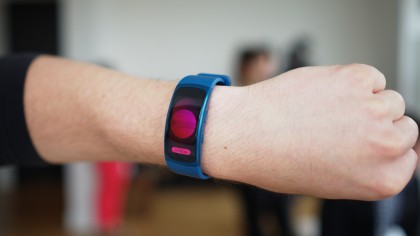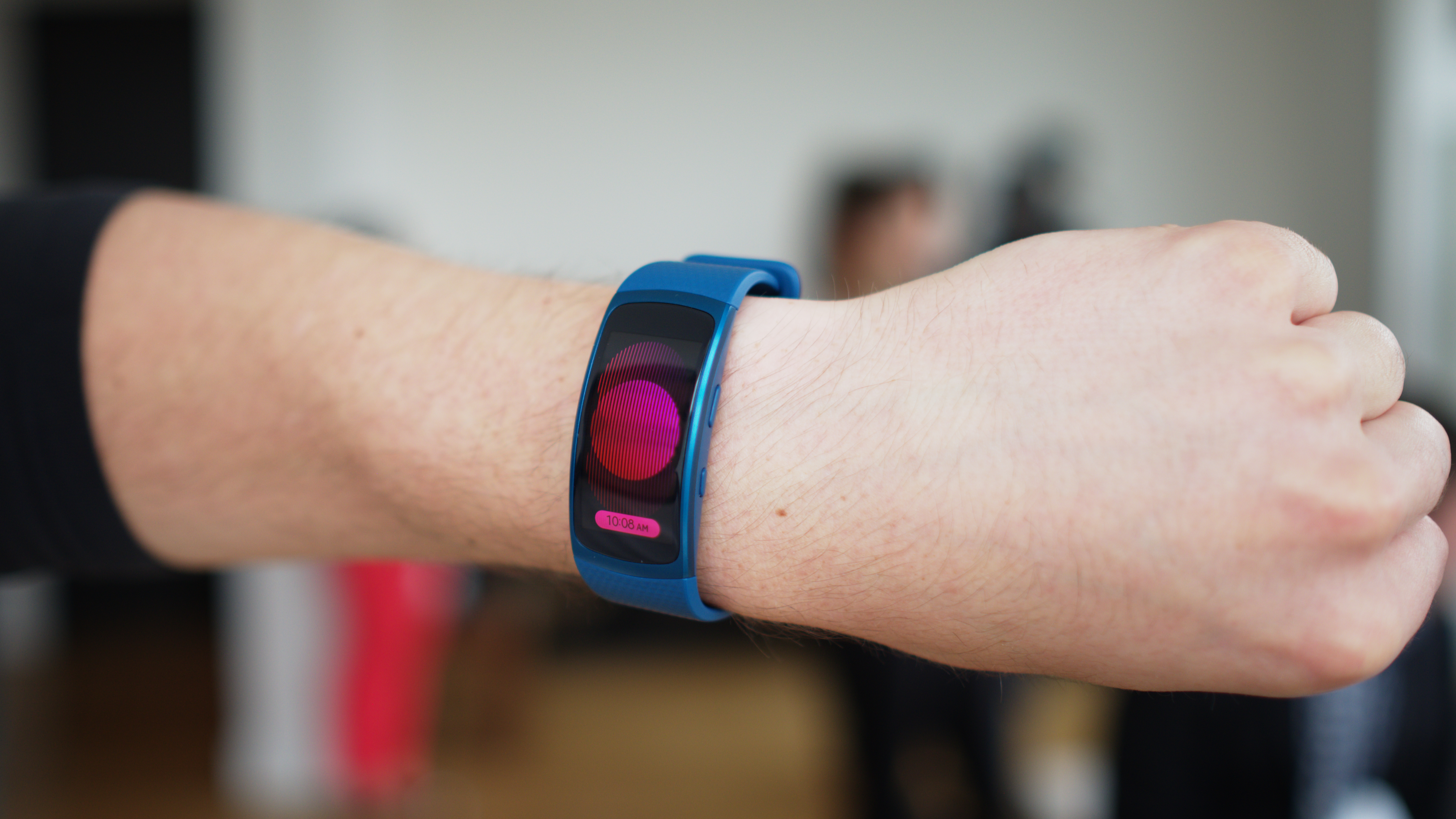Why you can trust TechRadar
Samsung made a lot of improvements to the outside of the Gear Fit 2. So, it's little surprise that its innards have received some love, too.
On the hardware side of things, the Gear Fit 2 is a step up in nearly every way. Much like the Microsoft Band 2 shamed the first Band, so Samsung's latest tracker also makes its predecessor look bad.

It features the same dual-core Exynos 3250 clocked at 1.6GHz found in the Samsung Gear S2, way up from the custom M4 processor that ran at 160MHz in the Samsung Gear Fit.

Compatibility: Phones running Android 4.4+ or iOS 9
Display: 1.5-inch Touch Curved AMOLED
CPU: Dual-core 1GHz
Storage: 4GB
Battery life: 200mAh - 3 to 4 days
IP rating: IP68
In another slightly embarrassing comparison, the Gear Fit 2 spanks it again with 512MB RAM and 4GB of onboard storage for music and installing Samsung-made apps in the near future. The previous Gear Fit came with 8MB RAM and 16MB of ROM storage.
The Samsung Gear Fit 2 runs on Tizen, the company's own pride and joy of an operating system. Again, like with the Gear S2, opting for its own OS doesn't lead to more exclusivity in regards to the phones it can operate with, but less. As such, it works with any Android phone running KitKat or above. And recently, Samsung did iPhone users a favor and made it compatible with any phone running iOS 9 and above.
While Samsung has opened the party to a greater audience, you'll need a few apps to get started. First off, the Samsung Gear app to setup and periodically update the Gear Fit 2 and another app, S Health to dig into your fitness metrics in more detail. And although setting things up is fairly simple, two apps required is one too many.
Performance
Much like the first Gear Fit, one of the Gear Fit 2's marquee features is that it now shows notifications from your smartphone. But, as a fitness tracker, it obviously does much more than that, and doesn't even need your smartphone to operate.
Right from the start, the Gear Fit 2 makes it clear that it's totally cool if you don't want to set it up with a smartphone. So, for a while, that's exactly what I did.

As someone who doesn't exactly have fitness hard-wired into their daily schedule (that's putting it lightly), the Gear Fit 2 loved reminding me of my laziness. Aside from the customizable alerts to get up and move around, Samsung's tracker also begins an "inactive timer" right on the home screen, which keeps track of the amount of time that you've been stationary.
Just as the Gear Fit 2 automatically tracks your lack of movement, by utilizing its bundle of sensors, (which include a heart rate monitor, accelerometer, gyroscope and barometer) this tracker can independently detect walking, running, lifting or some light yoga, to name a few, without any input from you.

Even without pairing the Gear Fit 2 to a smartphone, it's able to offer a fairly intuitive and useful read-out of your daily fitness metrics. Calories, for an example, are broken down in a timeline format and illustrates the general intensity of your movements throughout the day. Some people, like myself, are pretty content with this top-level knowledge alone.
This fitness-centric adaptation of Tizen OS is made up of slides that are dedicated to different methods of fitness. Each one offers a compact, but surprisingly detailed glimpse into your recent progress.
Of course, once paired with an Android smartphone, the experience only grows from there. If you've installed Samsung Gear and S Health onto your compatible Android or iOS smartphone, the Gear Fit 2 will automatically feed it your fitness metrics.

Aside from the greater depth in detail, the biggest change you'll encounter when it's connected to a phone is the slew of notifications coming through. The Gear Fit 2 does a good job of displaying them and providing a dedicated space for them to live, which is just a right swipe away from the home page. And if they become too annoying, you can turn off the vibration effect that each one triggers.
Though most notifications are simply an FYI, you can take limited action on some of them. Gmail, for instance, allows you to delete, archive, or reply with a small list of basic responses.
As part of its notification services, the Gear Fit 2, of course, displays texts and even notifies you of a call coming through. You can tweak the text replies to better fit your character so that a quick text reply to a missed call actually seems like something you'd type and less robotic than the default options.
The Samsung Gear Fit 2 has received a tech spec overhaul and as a result, it's zippy, even when tracking an exercise and overloaded with notifications coming through. The general day-to-day experience was a pleasant one, which its comfort, the capabilities of its hardware and the Tizen OS each play a part in providing.
Fitness
When you put "Fit" in the name of your product, people expect a certain level of fitness features. The Gear Fit might have been competent for its time in 2014, but the fact that you couldn't pause a workout and that accuracy was questionable are puzzling issues in hindsight.
First off, pausing a workout is done by simply tapping the back button. Problem solved.

In regards to accuracy, I strived to utilize each of its tracking functions to get a good sense of how well it was able to capture what I was actually doing. And the take away is a rather good one.
I felt confident at the end of each day that the Gear Fit 2 showed me the work that I put in. Tracking with the Microsoft Band 2 on my other wrist, the metrics mirrored each other nearly to a tee.
The only low point that I encountered was when the device would suddenly tell me that I had just climbed 10 flights of stairs, when in reality, I had only walked for five minutes straight to the subway. On another day out walking, it told me that I had shattered my previous record by a whopping 170 flights of stairs.

This is obviously problematic, but the Samsung rep affirmed that it's simply an issue caused by showering with the Gear Fit 2. While the device is IP68, contact with water appears to heavily (although temporarily) screw with the barometer's sense of altitude. It's possible that a fix could be patched through, but for now, I'm going to leave it on the nightstand while I wash off.
The added GPS functionality is an awesome inclusion. Runners will love this, as will walkers, too. It's mostly just for reference and comparing outings, though Samsung did build a Facebook share button to brag to your fitness homies.
Aside from the novelty of the function, the best part about the GPS is that you can take advantage of without bringing your phone along.
Lastly, I felt that the heart rate tracking was accurate enough, but if you're training for a marathon or some other impressive feat, you'll be better served with a Bluetooth-connected chest strap, which can be set up through Samsung's S Health app.
That said, since this review was initially written the company has brought an update to the heart rate monitor that allows you to see how long you've spent in different levels of heart rate zone. That could be useful if you're looking to train intensively.
Current page: Specs, performance and fitness
Prev Page Introduction, price and display Next Page Compatibility, apps and battery lifeCameron is a writer at The Verge, focused on reviews, deals coverage, and news. He wrote for magazines and websites such as The Verge, TechRadar, Practical Photoshop, Polygon, Eater and Al Bawaba.

